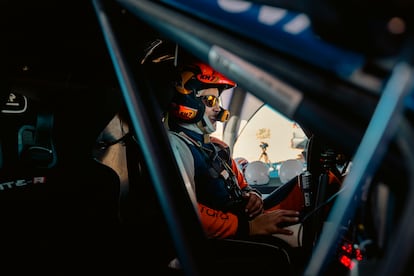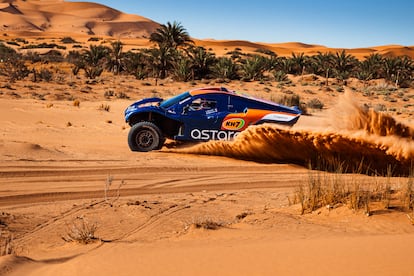Rally raid star Laia Sanz flies over desert dunes ahead of the Dakar 2024
We took a spin with Catalan race driver Laia Sanz on her last day of training in the Sahara. On January 5, after a lifetime on a motorbike, she will race her third Dakar behind the wheel of a car, and her fourteenth overall. The race is notoriously harsh, but she has never once not finished it

The surge in the throttle kicks up a cloud of sand, orange and as powdery as silt. In a few seconds — maybe two, maybe three — you’re going so fast your body sucks against the seat like jelly to a mold. You try to see. You can’t. The force of the 105-mph velocity makes your heavy helmet slump down over your eyes and forehead. You can’t turn your head, because it’s locked in a neck brace to prevent you from becoming a paraplegic in the not unlikely event of a crash. Suddenly, through the windshield, you no longer see sand, but an infinity of blue: the sky. And suddenly, your insides shrink like a piece of paper crumpled into a ball. Before you realize that what you’re feeling is vertigo, and that you’re flying across one of the largest sand dune seas in the deserts of Morocco, you hear a cry of enthusiasm through the headphones integrated into your helmet: “Yiujuuu!” And then, a laugh. Short, loud, sincere: the laughter of Laia Sanz (Corbera de Llobregat, Spain, 38), the only female rider to have raced 13 Dakar Rallies in a row without ever dropping out.
Reviewing Sanz’s sporting career is like entering a room filled with trophies. She is the winner of Spain’s National Sports Awards and took gold in the Royal Order of Sporting Merit; she is a 14-time winner of the FIM Trial World Championship; 10-time winner of the FIM Trials European Championship; 6-time World Enduro Champion; 7-time winner of the Trial des Nations; and 13-time participant in the race of races: the Dakar Rally, which she also won 13-times in the women’s category. In other words: she started and finished 13 Dakar races, 11 of them on a motorcycle, the last two in a dune buggy.

“One time, at a Dakar Rally, I basically went unconscious. I finished a leg of the race, and I didn’t remember a thing. But I still finished that Dakar. Things have to get pretty bad for me not to finish a race,” Sanz says. At another Dakar Rally, in 2021, she raced while suffering from Lyme’s Disease after being bitten by a tick, with her body exhausted and her brain turned to mush. “It was a matter of pride to finish it,” she says, without giving it much thought. “Laia is determined,” explains Diego Vallejo, her fellow racer and a Spanish off-road rally champion, as well as a five-time Dakar competitor. “No one in their right mind finishes all their Dakars. One year I saw her on a bike. Her engine broke down and her partner had to tow her 400 kilometers, with her swallowing mud the whole way and doing everything she could to keep from giving up.”
The incident Vallejo is referring to occurred during the 2013 race. In the ninth leg of the race, Sanz’s engine started gushing oil. She had to stop to avoid ruining the engine. Her backup support, Miguel Puertas, was tasked with towing the dirt bike 400 kilometers to avoid having to quit the race. In the end, they reached the bivouac rest station at five in the morning. After 15 hours of riding, she was the last to arrive. But she kept going. At 8:20 a.m. the next day, after resting a mere three hours, she got back on her newly repaired bike to complete the tenth leg of the Dakar. She lost her chance of finishing in the top 30, but was crowned the winner in the women’s category.
Two years later, in 2015, Sanz achieved her best result in the Dakar, winning ninth place in the overall race and breaking the all-time record in the women’s motorcycle category. Laia Sanz became a legend. Parents started naming their daughters Laia, not after Saint Eulalia, the patron saint of Barcelona, but after Laia the rally driver. The media baptized her “the motorcycle queen,” “the princess of Dakar,” and “the queen of the desert.” She had to defend herself in interviews, insisting that she was not “a freak” for being a woman who rode dirt bikes better than most men, and emphasizing that one day she hoped to get married and have children. “I might miss the boat,” she says wryly, as the freezing, diaphanous desert night falls around us. “It’s definitely an issue, and it’s not getting any easier, because I’m starting to get older, and yeah, I’m getting more and more worried. I feel like being a woman is much more difficult than being a man, because I can’t stop my career right now. When I had the position I had riding bikes, I could have just told my team, ‘I’m going to stop riding for a year because I want to be a mother, and then I’ll come back,’ and they would have saved my spot. But now I can’t afford it. Is the desire there? Yes, but if I stop my career, I won’t be able to come back.”

It’s during the short-distance races when you witness the full depth of Sanz’s determination. Before each race, her mother sends her a message with just three words: “Sort i seny” (“luck and good sense,” in Catalan). His father prefers a longer phrase: “Where there’s a will there’s a way,” a saying Sanz also used to title her book, which recounts her experience during the 2015 Dakar Rally. Her determination is not borne from a desire to show off for others, but rather to surpass her own self. Even in the case of the toughest and most dangerous race in the world, which has taken the lives of 27 riders since it began in 1978. “I’ve always said that there were people at Dakar, especially guys on motorcycles, who bought more entries than me just to end up badly. They took risks that I would never take, because I prefer to finish tenth rather than seventh if it means I can finish in one piece,” she says.
Wearing a Red Bull baseball cap and an Astara team sweatshirt, Sanz appears unfazed by the brilliance of the regal brand logos that have been bestowed upon her throughout her career. Her face has no makeup. Her nails are cut short. Her forearms are tanned from riding her bike in her spare time, and they are covered in scratches. Years of doing interviews have made her somewhat reserved, and she only lets down her guard when talking about her cats (she has three, she shows me their pictures on her phone) and when she steps into her race buggy. At that moment, she starts to smile, loosens up, jokes with the team, and forgets about the press. She gets into her car like someone slipping into a tailor-made suit. A childish gleam dances in her eyes, a reminder that her love affair with motorcycles began as a game, and turned into a passion and a job before she learned that the world is governed by bosses, salaries and performance grades.
One afternoon, Sanz’s parents heard the sound of a motorcycle. When they looked out the window, instead of seeing their nine-year-old son Joan, they saw five-year-old Laia riding around the garden on her brother’s Cota 25. They didn’t punish her, but instead, when Laia turned seven, her mother signed her up for a race in the Catalan junior motorcycle championship. She came in eighth out of a total of eight participants. The experience helped her realize that from then on, she preferred to win. And that, in almost every case, she was going to be the only woman in the race.
—Don’t you sometimes feel lonely being the only woman?
—No, I’ve always been surrounded by boys. I’m just another one of the guys.
—What does it take to be one of the guys?
—I mean, I’ve had to prove myself. You have to earn respect. The problem is that you have to earn it, whereas others arrive and automatically have it. I earned it and then I was treated very well, for the most part.
—Have you also been treated badly?
—Yes
—For example?
—It’s silly and sounds materialistic, but all the drivers on the team flew business class and I didn’t. I don’t have a problem with it, but... why did everyone fly business and I didn’t?
“Ultimately you have to just grind away at it, keep going, and then you’ll get there. Sometimes I have the feeling that for a lot of my life I’ve had to row against the current a little bit, but in the end, I think that just makes you stronger and it’s what has made me get to where I am... I don’t know, at the end of the day, I feel lucky,” Sanz says.
Lucky, she says, because riding dirt bikes has allowed her to lead the life she wants — a life that feeds her soul. And because she has the fortitude to resist defeat, and a mind capable of total concentration during a race, but that still lets her disconnect and relax when it’s all over. A mind, too, that despite all the pressures, has yet to require therapy. “I tried it once and I didn’t like it, and I thought: my head is my best asset in races, why would I want to mess with it? We’ll see if I eventually break,” she says.

After a lifetime on a motorbike, three years ago, Sanz received a call from champion Spanish rally driver Carlos Sainz. “I was shocked. He had been my idol all my life,” Sanz says. “The only day my parents let me skip school was to go to see him at the Rally Catalunya.” Sainz came to her with a proposal: that she come drive for his Acciona Extreme E team. She accepted, despite having no experience with cars. That was in 2020. In 2021, she would leave her bike behind to race with the Mini team in the Dakar Rally. In 2024, she will race with team Astara, just as she did in 2023. Her ride of choice — the buggy with which she will compete in the T1.2 car category — is powered by electrofuel, or e-fuel, a type of synthetic fuel with a neutral carbon footprint (zero emissions), and it is the least polluting car in the entire race. “The switch [to cars] has been hard, because I had to get out of my comfort zone, but that’s just life. Because of my age, my body’s not the same anymore. On top of the deaths of colleagues, which really leaves its mark, taking that risk and racing motorcycles, knowing that anything can happen to you... I think I switched to cars at the perfect time,” she says.

The dunes are impassive, like prehistoric animals. Sanz’s car cools off under a tent in the middle of the Moroccan Sahara. This is her last chance to train with the same machine she will use during the Dakar Rally, before she flies to Saudi Arabia in January. A woman competing in a race of, for, and created by men, in a country where men only began allowing women to drive five years ago. “Yeah, you know what it’s like, but what are you going to do? If they send you to Saudi Arabia for work, you wouldn’t go? This is my job, and I have to go even if people criticize it,” she says.
This time around, Sanz won’t be getting covered in mud kicked up by her motorbike. Nor will she be alone. On January 5, when the first leg of the race starts, Maurizio Gerini will once again join her as co-pilot, reading the roadbook that maps out the route in Italian, a language that Sanz also speaks. Behind her, she will be supported by a whole team.
—We have to run a smart race this year at Dakar, to do better than we did last year.
—What does doing better look like?
—I don’t want to say. It would be bad luck.
Sign up for our weekly newsletter to get more English-language news coverage from EL PAÍS USA Edition
Tu suscripción se está usando en otro dispositivo
¿Quieres añadir otro usuario a tu suscripción?
Si continúas leyendo en este dispositivo, no se podrá leer en el otro.
FlechaTu suscripción se está usando en otro dispositivo y solo puedes acceder a EL PAÍS desde un dispositivo a la vez.
Si quieres compartir tu cuenta, cambia tu suscripción a la modalidad Premium, así podrás añadir otro usuario. Cada uno accederá con su propia cuenta de email, lo que os permitirá personalizar vuestra experiencia en EL PAÍS.
¿Tienes una suscripción de empresa? Accede aquí para contratar más cuentas.
En el caso de no saber quién está usando tu cuenta, te recomendamos cambiar tu contraseña aquí.
Si decides continuar compartiendo tu cuenta, este mensaje se mostrará en tu dispositivo y en el de la otra persona que está usando tu cuenta de forma indefinida, afectando a tu experiencia de lectura. Puedes consultar aquí los términos y condiciones de la suscripción digital.
Archived In
Últimas noticias
Most viewed
- Sinaloa Cartel war is taking its toll on Los Chapitos
- Oona Chaplin: ‘I told James Cameron that I was living in a treehouse and starting a permaculture project with a friend’
- Reinhard Genzel, Nobel laureate in physics: ‘One-minute videos will never give you the truth’
- Why the price of coffee has skyrocketed: from Brazilian plantations to specialty coffee houses
- Silver prices are going crazy: This is what’s fueling the rally









































